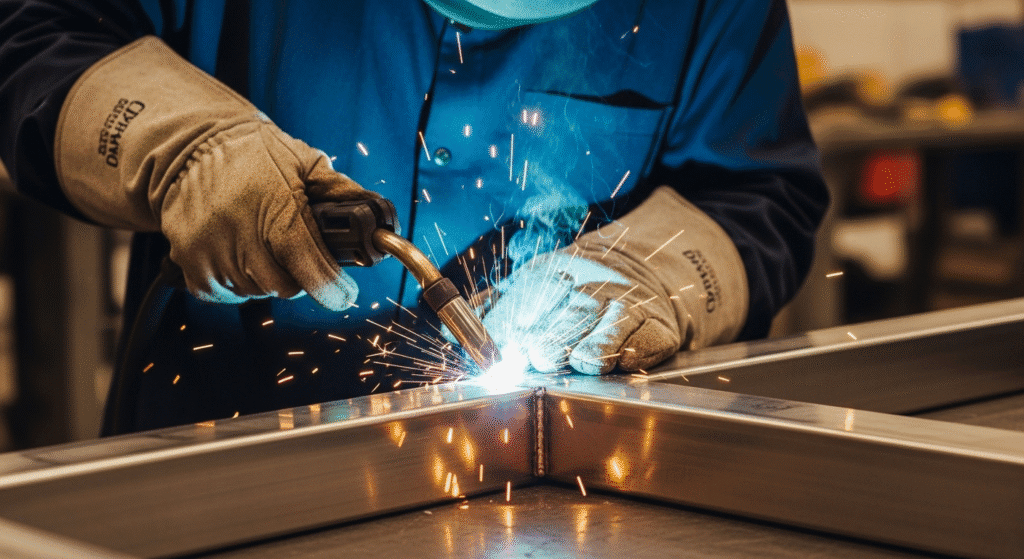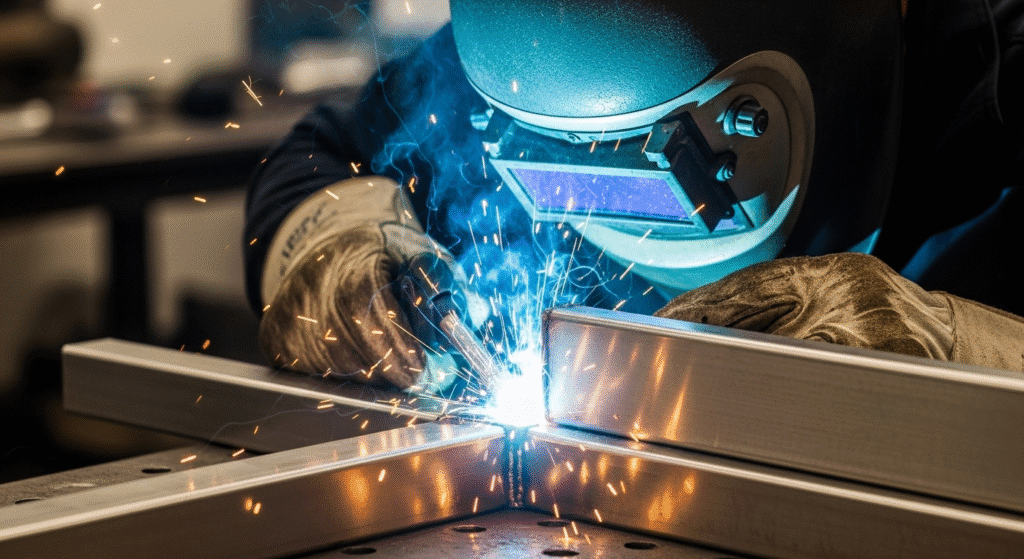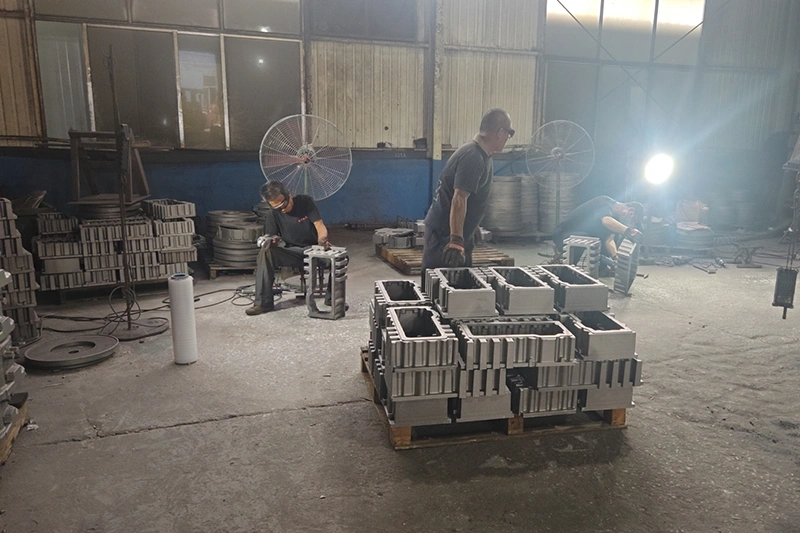Stainless steel welding requires specific techniques and careful attention to detail that go beyond regular steel welding. The material’s unique properties – high chromium content for corrosion resistance, lower thermal conductivity, and higher thermal expansion – make it both valuable and challenging to work with.

Yes, you can weld all types of stainless steel, but each type requires different techniques and precautions to achieve strong, corrosion-resistant welds. The weldability depends on the stainless steel’s metallurgical structure – whether it’s austenitic, ferritic, martensitic, or duplex.
TIG welding produces the highest quality stainless steel welds with minimal cleanup and a smooth “stack of dimes” appearance. The process uses a non-consumable tungsten electrode and argon shielding gas, giving you precise control over heat input through a foot pedal or fingertip control.
TIG excels when welding thin stainless sheet metal or when appearance matters – like food-grade equipment, medical devices, or architectural features. You can even weld without filler metal for ultra-thin materials, creating crevice-free joints perfect for sanitary applications.
The main drawback is speed. TIG is the slowest welding process and requires significant skill – you’ll need to coordinate both hands and often a foot pedal simultaneously. Any contamination on the metal or electrode will cause defects, so meticulous cleaning is essential.
MIG welding offers the best balance of speed and quality for general stainless steel fabrication. The continuously fed wire electrode makes it much faster than TIG, and most beginners can achieve decent welds with just a week or two of practice.
For stainless steel, you’ll typically use an argon-based gas mix – often a tri-mix of 90% helium, 7.5% argon, and 2.5% CO₂ for short-circuit transfer. The process works well for structural components, frames, and equipment where strong welds matter more than perfect aesthetics.
MIG can’t match TIG’s cosmetic perfection and requires clean metal for best results. Wind sensitivity is also a concern – even a moderate breeze can disperse the shielding gas and cause porosity. For very thin stainless, MIG’s continuous wire feed may introduce more heat than desired.
Stick welding’s biggest advantage is portability and its ability to handle outdoor conditions. The flux-coated electrode provides its own shielding, so you can weld stainless steel in wind or rain that would ruin gas-shielded processes.
This makes stick welding ideal for field repairs and maintenance work on stainless steel. The equipment is simple and affordable – just a power source, electrode holder, and ground clamp. Stick electrodes can also tolerate less-than-pristine surfaces better than MIG or TIG.
However, stick welding is slower with frequent electrode changes, and each pass leaves slag that must be chipped off. It’s not suitable for thin stainless steel under 2mm, as the intense arc easily causes burn-through. The finished welds typically need grinding if appearance matters.

Remove all contamination from the joint area using acetone or alcohol, then mechanically clean to a bright shine. Use only stainless steel wire brushes or grinding discs – never use tools that have touched carbon steel, as embedded iron particles will cause rust later.
For TIG welding, use 100% argon at 15-20 CFH flow rate. MIG typically requires an argon-based mix with flow rates of 25-40 CFH.
When welding full-penetration joints like pipes, use back purging with argon to prevent oxidation on the root side. This ensures the inside of the weld stays as clean as the outside.
Match your filler to the base metal for optimal corrosion resistance. Use ER308L for 304 stainless, ER316L for 316 stainless, and ER309L when joining stainless to carbon steel.
Always choose low-carbon “L” grade fillers to minimize chromium carbide formation that can reduce corrosion resistance. For austenitic stainless, the filler should produce 5-10% ferrite in the weld to prevent hot cracking.
Stainless steel expands more than carbon steel but dissipates heat slowly, making it prone to warping. Use short weld passes and faster travel speeds than you would with carbon steel.
For thin sections, consider backstep welding or skip welding to distribute heat. Allow cooling between passes, and never water-quench stainless steel – let it air cool naturally to prevent distortion and cracking.
A properly shielded stainless TIG weld should show a shiny silver or light straw color. Dark blue or gray indicates insufficient shielding or excessive heat.
Remove any heat tint with a stainless wire brush or pickling paste to restore full corrosion resistance. For critical applications, the weld area should be passivated with nitric or citric acid to reform the protective chromium oxide layer.
Use 100% argon for TIG welding stainless steel. For MIG, use an argon-based mix like 90% helium, 7.5% argon, 2.5% CO₂ for short-circuit transfer, or 98% argon, 2% oxygen for spray transfer.
Yes, use ER309L filler metal which has high alloy content designed to tolerate mixing with mild steel while maintaining good weld properties.
Blue or gray discoloration indicates insufficient shielding gas coverage or excessive heat input. Increase gas flow rate, use a gas lens for better coverage, and reduce heat input.
Austenitic and duplex stainless steels don’t require preheating. Martensitic grades need 200-300°C preheat to prevent cracking. Ferritic grades may benefit from 50-250°C preheat in thick sections.
Use faster travel speeds, short weld passes, and backstep or skip welding techniques. Clamp securely but not over-restrained, and allow cooling between passes.
TIG welding provides the best control for thin stainless steel under 3mm, preventing burn-through while maintaining good appearance.
While the welding machine can be the same, use separate consumables and tools. Dedicated stainless wire brushes, grinding discs, and MIG gun liners prevent iron contamination that causes rust.

